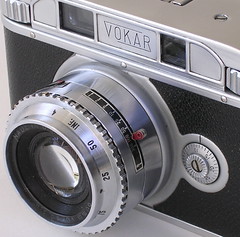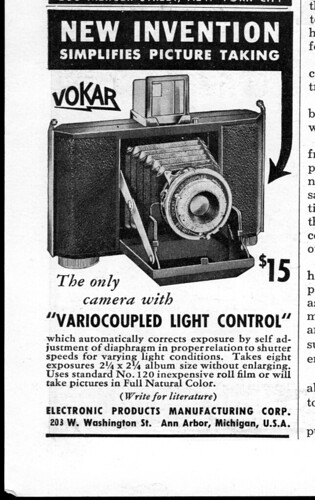Difference between revisions of "Vokar"
(→Related Models: added Voigt) |
m (→Related Models) |
||
| Line 48: | Line 48: | ||
* [[Voigt]] | * [[Voigt]] | ||
* [[Voigt Junior]] (1946-)<ref>[http://wphs-tucson.blogspot.com/2009/06/argus-vershoor-and-vokar.html Western Photographic Historical Society]</ref> | * [[Voigt Junior]] (1946-)<ref>[http://wphs-tucson.blogspot.com/2009/06/argus-vershoor-and-vokar.html Western Photographic Historical Society]</ref> | ||
| − | * [[Wirgin_Junior | + | * [[Wirgin_Junior]] (a Voigt Junior Variant) (1946-)<ref>[http://www.cameramanuals.org/pdf_files/wirgin_junior.pdf Manual for the Wirgin Junior at OrphanCameras]</ref> |
* [[Wirgin Deluxe]] (1946–) an Art Deco encased version of the [[Voigt Junior]] | * [[Wirgin Deluxe]] (1946–) an Art Deco encased version of the [[Voigt Junior]] | ||
* Montgomery Wards Folding Camera (Vokar A variant offered in 1941 catalog) | * Montgomery Wards Folding Camera (Vokar A variant offered in 1941 catalog) | ||
Revision as of 03:00, 21 March 2011

|
| Vokar I rangefinder image by Rick Oleson (Image rights) |
Cameras and other photo products with the brand Vokar were produced by Electronics Products Manufacturing Corp., located in Ann Arbor, and then Dexter, Michigan, USA. In 1945 the company name itself became Vokar[1].
History
Many sources (including earlier wiki articles) have stated that the Vokar brand was created by Charles Verschoor, who was ousted in 1938 as president of the company who made Argus cameras[2]. However there is little documentary evidence to support this; and the confusion may be caused because Electronic Products Manufacturing was founded by a different ex-Argus man, Robert Wuerfel. The first location advertised for Vokar products, 208 W. Washington St.[3], was a mere 1/3 mile from the Argus factory.
Cameras
By late 1939, this company began marketing photographic products using the brand name Vokar [4].
The basic Vokar camera was a simple folder for 6x6 exposures on 120 film. This appeared with different lenses & shutters and in slightly different styles. Electronic Products also introduced several slide projectors, one in bakelite and two in "streamlined" metal[5]. Despite the grandiose name, the latter used an inexpensive folded-steel case. This was also sold by the Sears chain under their Tower brand, and was apparently one of the firm's more successful products.
At some point, EPM engaged Richard H. Bills to design a completely new and highly sophisticated 35mm rangefinder camera, and this is the model the Vokar name is best known for today. Development costs for the camera were said to run to some $250,000[6], but the design was to leap well ahead of the blocky C3 rangefinder that Argus was now manufacturing.
In 1942, the company relocated to more rural environs outside Dexter, Michigan (a move of about 8 miles west). During the World War II period, Electronic Products Mfg. Corp. converted entirely to defense contracts, making parts for proximity fuses[7]. Sales of the simple bakelite folders ceased. After the war, curiously-similar 6x6 folders emerged from Camera Specialty Company of New York City under the Voigt and Wirgin names; the exact connection between the two companies remains to be clarified.
In 1945 the Electronic Products Mfg. turned its attentions back to the photography market; and in its December magazine advertisements, it now carried the name "Vokar Corporation"[8] The ads also included a tantalizing note: "Watch for Announcement of the New and Finer Vokar Camera." This was the long-awaited Vokar I rangefinder, which was finally advertised in January 1946[9]—only to disappear for another 9 months, again replaced by the teaser "watch for announcement… ". Finally, in the fall of 1946, advertising for the Vokar re-appeared, and now quoting a price[10]—suggesting the camera was at last available.

|
| Vokar folder introduced, 1940 image by scan courtesy Voxphoto (Image rights) |
The ambitious camera had its share of teething troubles, and the undercapitalized firm failed to make much of a dent in the US camera market. Despite a modest 1948 revision, the Vokar II, the company sank from view (and returned to electronic products). The final dissolution of the company is recorded in 1964, but its participation in the photography market had ended much earlier.
Vokar Models
- Vokar A (1940–)
- Vokar B (1946-) also sold as the Vokar I (advertised 1946 and 1947)
- Vokar I (1946-)
- Vokar II (1948-)
Related Models
- Voigt
- Voigt Junior (1946-)[11]
- Wirgin_Junior (a Voigt Junior Variant) (1946-)[12]
- Wirgin Deluxe (1946–) an Art Deco encased version of the Voigt Junior
- Montgomery Wards Folding Camera (Vokar A variant offered in 1941 catalog)
Notes and References
- ↑ Vokar advertisement noting the name change, Popular Photography (US magazine) December, 1945, pg.137.
- ↑ Gambino, Henry J. Argomania: A Look At Argus Cameras and the Company That Made Them. Doylestown, PA: Aeone Communications 2005. ISBN 0-9770507-0-X
- ↑ No trace of this building remains; the site has been a parking lot for several decades
- ↑ For example the Vokar A camera, advertised 1940, from Sylvain Halgand's www.collection-appareils.fr "Variocoupled Light Control" seems to have been been a primitive manual form of programmed exposure.
- ↑ "Available Now — The New Streamlined Vokar Projector" (advertisement) Popular Photography November 1945, pg 121.
- ↑ Lahue, Kalton C. and Bailey, Joseph A. Collecting Vintage Cameras Volume 1: The American 35mm. American Photographic Book Publishing Co., 1972, pg. 154
- ↑ "Trade Notes and News" Popular Photography January 1946, pg.64
- ↑ Vokar advertisement in Popular Photography, December 1945, pg. 137.
- ↑ "Excellence… Vokar I" (advertisement) Popular Photography, January 1946, pg. 107
- ↑ Finest… Vokar I (advertisement) Popular Photography, November 1946, pg. 12
- ↑ Western Photographic Historical Society
- ↑ Manual for the Wirgin Junior at OrphanCameras